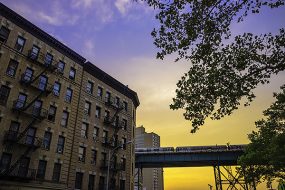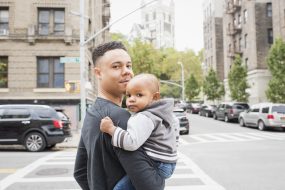The Harlem Health Advocacy Partnership
NEW YORK UNIVERSITY-CITY UNIVERSITY OF NEW YORK PREVENTION RESEARCH CENTER
Public Health Problem
With the lack of affordable housing, limited access to healthy foods, and an unsafe built environment, East/Central Harlem residents in New York City experience more health issues and barriers to health care than residents living in other parts of New York City. Fifteen percent of Harlem residents do not have a regular doctor, and 18% visit the emergency department for routine health care.1 Many residents must also travel outside of their neighborhoods to access health education and care.
PRC Response

In 2014, the New York University-City University of New York Prevention Research Center (NYU-CUNY PRC) partnered with the New York City Department of Health and Mental Hygiene (NYC DHMH), New York City Public Housing Authority, and community-based organizations to form the Harlem Health Advocacy Partnership (HHAP). HHAP connects residents of public housing with community health workers and health advocates to reduce the number of residents with uncontrolled asthma, diabetes, and high blood pressure.
The New York City Health Department used surveillance data to identify the five housing projects with the highest rate of poorly controlled diabetes—King Towers, Taft, Johnson, Clinton, and Lehman Village. From December 2014 to January 2015, HHAP worked with NYU-CUNY PRC to complete a needs assessment, which included a telephone survey and six focus group discussions. This input informed the program design, staff trainings, and intervention curriculum and protocol development. From 2015 to 2019, the PRC helped develop and implement an evaluation of HHAP.
During 2015, the first year of the HHAP program, NYU-CUNY PRC identified 200 residents from the five housing projects who were interested in working with community health workers to improve their health. They identified another 200 residents in other nearby public housing developments with similar demographic and health characteristics. All 400 residents were monitored to assess program impact.
“Health departments typically do not run community health worker programs, so the Harlem Health Advocacy Partnership program was truly a novel approach to bridge community and health care in a historically disadvantaged community, and everyone worked hard to make it a success.”
Accomplishments

Compared to residents in other public housing developments, HHAP participants showed an improvement in their ability to manage their health conditions through increased physical activity. Participants lowered their average A1C, an indicator of diabetes control, by a net difference of 0.4%.2 By the end of the program, more than 1,500 residents had participated in the program, and many of the walking clubs and support groups that HHAP created are still active in the community today.2
The HHAP initiative shows how partnerships between academic institutions and health departments can lead to innovative public health programs and policies.
“The NYU-CUNY Prevention Research Center has been a key partner for HHAP,” said Noel Manyindo, MD, MBA, MPH, assistant commissioner of the Harlem Neighborhood Health Action Center in the NYC DHMH. “Their integration of methods and data sources, including survey data, administrative data, qualitative data, and implementation science approaches, has produced a deeper understanding of the implementation and outcomes from this multi-level intervention.”
Since wrapping up the initial evaluation in 2019, NYU-CUNY PRC has continued to collaborate with HHAP to jointly disseminate intervention findings and protocols to support its sustainability and scalability. In 2021, HHAP expanded to include more East Harlem public housing developments. The program has served as a model for a larger post-COVID-19 community health worker program in select NYCHA neighborhoods, known as the Neighborhood Health Corps.
- NYC Health. Launching a Neighborhood-Based Community Health Worker Initiative: Harlem Health Advocacy Partners (HHAP) Community Needs Assessment Available at https://www1.nyc.gov/assets/doh/downloads/pdf/dpho/neighborhood-based-chw-iInitiative.pdf. Accessed December 5, 2022.
- NYC Health. Concept Paper: Harlem Health Advocacy Partners Community Health Worker Program. Available at harlem-health-advocacy-partners-concept-paper.pdf. Accessed December 5, 2022.